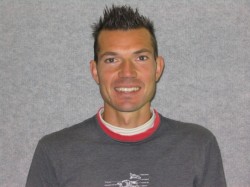
Senior Physiologist, Australian Institute of Sport
Running has been a major part of my life for the past 20 years as an elite athlete, sports scientist and coach. I have trained with, tested, observed and talked with runners of all levels of ability from developing juniors, recreational runners, elite senior athletes and Olympians. Like many runners I have been brought up with the premise of trying to increase the amount and intensity of training in order to improve performance, and for many talented runners this works well. However, just training hard is not necessarily the best option for runners with deficiencies in muscle strength, muscle activation patterns and other aspects associated with good running technique. These runners could succumb to injury by just increasing their volume of training.

The importance of building strength, gradually increasing mileage and incorporating a consistent strength and conditioning program into running training has become more evident to me as I have progressed through the years as an athlete, scientist and coach. Much of my PhD looked at improving running economy in highly trained distance runners and one of the key factors was improving the recruitment of key muscle groups such as the glute and hamstring muscles and utilizing the elastic energy stored in the muscle tendon system to gain more energy for less work in each foot contact. Currently, I use weight training, muscle activation work, plyometrics, running drills, static holds and sprinting for myself and the athletes I coach. This approach has consistently allowed us to run with better technique, be more resilient to injury and get through higher volumes of quality training year in year out.
At age 34 I continue to compete in major track events in Australia and have been a consistent top 10 performer at the National Championships over the last decade. I think a major reason I have had such a long career in the sport and am still going strong is that I have rarely been injured and have managed to consistently string together good training blocks each year. Part of the reason for this is definitely related to good running technique, which has allowed me to train at a high level for a long period.
Brian approached me a few years ago to provide him with some guidance to his training with his goal to improve all of his best times from when he was a junior runner and eventually build up to running a good marathon. Initially I provided ideas on how to build up his training volume and suggestions for the type of harder sessions that would improve his fitness and race performance. He did manage to improve some of his times, but unfortunately he became injured before he could complete that marathon.
Brian then began something of a quest to try and reduce the amount of time spent not running due to recurrent injuries. He completed a gait analysis video and sent me a copy for feedback. There were certainly many deficiencies in his running technique compared to the elite athletes I train with and compete against. It was clearly evident that Brian was much too heavy on the ground with a pronounced heel strike at contact and his foot was landing well in front of his hip. His back lift of the foot and leg after contact was nearly nonexistent and there was no bounce in his stride. All of these factors indicated a lack of glute and hamstring muscle activation and over emphasis of the quadriceps. There were obviously severe loads going through his legs on impact with the ground and it was not surprising he had been getting many injuries.
Brian then set about improving his running mechanics and did a lot of research on what factors are associated with good running technique, which he describes very well in this book. During the Christmas period of 2010-2011, I caught up with Brian who came up to Jindabyne to spend some time with my family, get some running done and show me how far he had come with the book and his running technique. I must admit the video analysis of his new running technique was very dramatic with definite glute and hamstring activation occurring, he was much lighter on his feet with a far more neutral foot contact and was getting a bit of bounce and rhythm in his stride.
When Brian asked me to write the foreword to this book I agreed instantly as I think it covers a critical aspect of successful running. Running technique is also an area that does not have a lot of easy to understand and practical advice for regular runners. This book is easy to read, well laid out and the ideas are based on sound scientific research, and observations the author has made through his own journey in improving his running technique. The book provides practical advice on how to improve running technique for runners of all levels of ability and will be a valuable resource for distance runners.
****